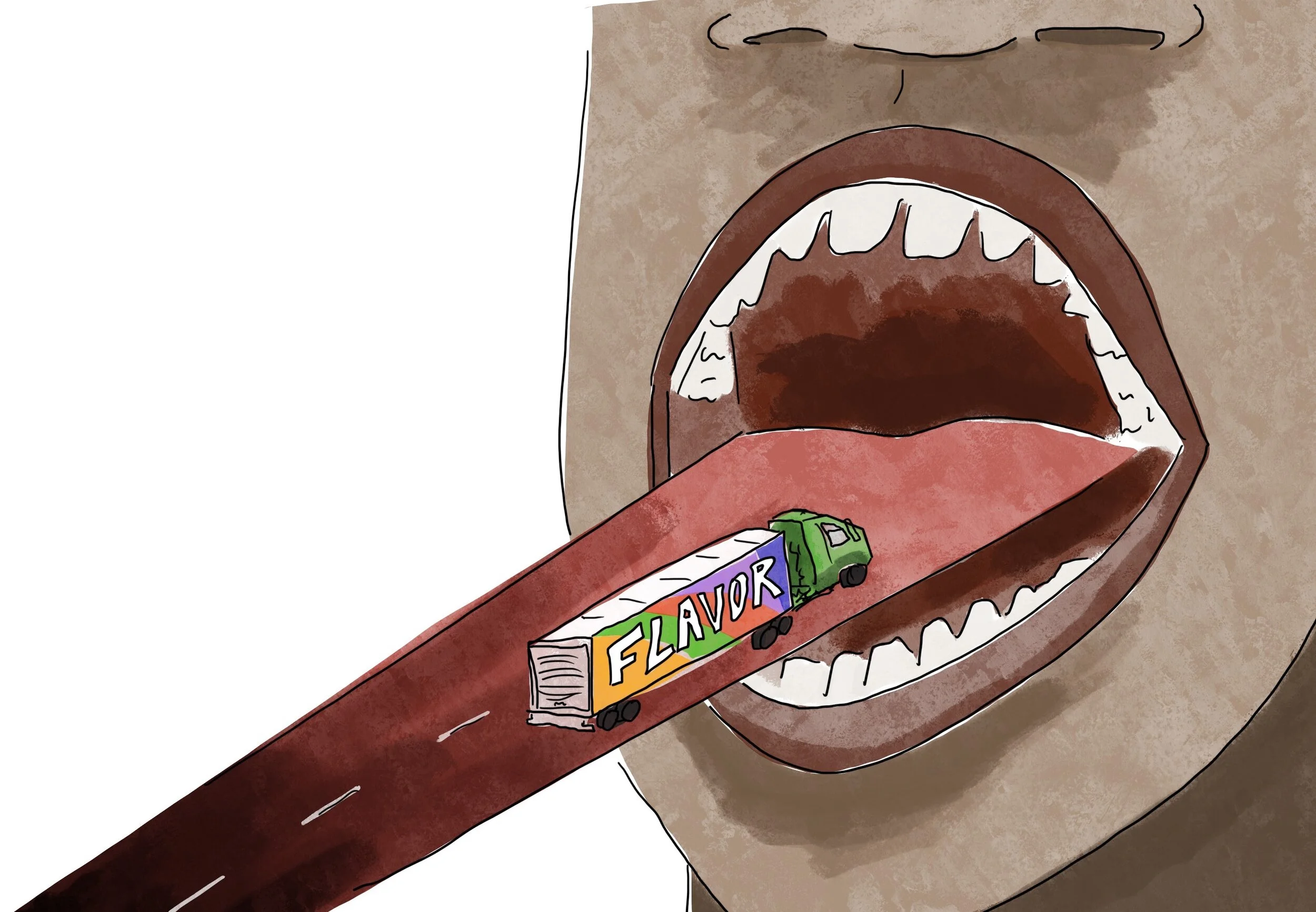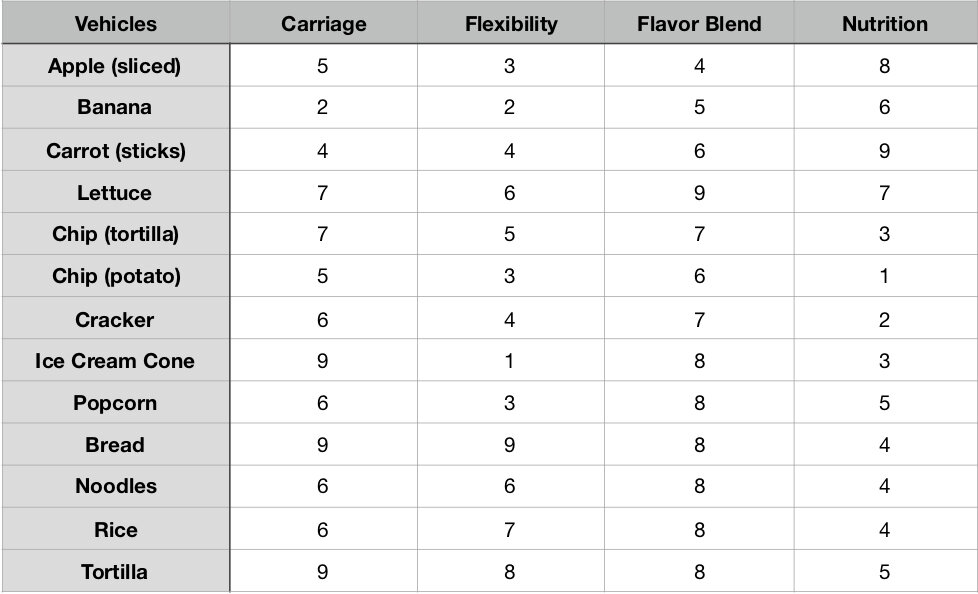Edible Flavor Vehicles
Food seems complicated. Our modern cuisine is a lush canopy held up by branching centuries of farming, opportunity, culture and globalization, all combining to form the meal before you. How did these ingredients come to be prepared in this way? In a fashion that we find delicious? It is a difficult question, one with a long, meandering answer.
Just as accurately, though, food is very simple. There are flavors, which taste good, and there are edible vehicles to transport those flavors. That’s about it. Some foods straddle the fence in-between, but many clearly fall into one or the other, flavors or vehicles.
The flavors category is difficult to analyze because flavor is somewhat subjective. This guy has a sweet tooth, that gal loves umami, dorkus here is a fiend for the sour stuff, etc. We’ve all heard it a million times. The vehicles category, on the other hand, can be more readily broken down into its component parts and objectively ranked. Which is our task today.
What’s the sitch with edible flavor vehicles?
A successful flavor vehicle has to be able to carry the flavor unfalteringly from plate to pallet, and enough of the flavor to satisfy. An ideal vehicle should also offer reasonable nutritional value. Lastly, for us to compellingly define this category of foods as vehicles (and not just foods to be paired with other, more flavorful foods), these vehicles need the flexibility to be used in multiple situations, with various flavors. (1,2) [these refer to endnotes.]
In the following analysis of edible flavor vehicles, the capacity to physically deliver flavor will be referred to as carriage, while the capacity to tastefully deliver in a variety of situations will be referred to as flexibility. (3,4) The flavor blend attribute will not be a judgement on whether the flavor of a given vehicle is better or worse, but rather whether the intrinsic flavor is overpowering or subtle, with a preference for the vehicles that are able to blend-in, facilitating unadulterated flavor delivery. (5) And the nutrition category will be a reflection of the nutrients and calorics of each vehicle, with less calories and more nutrients being desirable. (6)
To get a sense of the existing literature on edible flavor vehicles, we went to our trusted, curious friend Google. The search results can be seen below in figure 1.
We were as appalled by the bottom half of the page as I’m sure you all are (though the University of West Virginia edible car derby video is worth a watch). (7)
As is unfortunately commonplace, Google directed us toward the crude corners of the internet, not the informational ones. We were on our own, to come up with a list of edible flavor vehicles and to rank them based on their aforementioned attributes.
Results:
Bread: It should be no surprise to anyone that bread came out on the top after all was said and done. Bread is ubiquitous across cuisines and its flexibility is unchallenged. It can carry savory meats and cheeses as easily as sweet jams and butters. It soaks up shallow soups when spoons fail and other times is crafted into the actual bowl for soup to be held. Its carriage properties are second to none, a traditional flat platform with the added upside of a spongy absorbance. While there are a variety of bread flavors, some of them quite complex, on average it is not a strong or off-putting profile, well-suited to be an edible vehicle. Hats-off to you bread, still the champion after all of these years. If you’re reading this, congratulations and keep doin' what you’re doin’.
Tortillas: What fewer predicted before our analysis was that tortillas would end up tied with bread with 30 total points. When looking in detail at their attributes it becomes clear they deserve the spot. Tortillas often ferry a bulging mixture of meats, vegetables, grains and spices, which, in combination, only function as a respectable meal because of the effort of the taught, straining tortilla. They are easily smothered and coiled into a peanut butter and jelly roll, and are regularly served with soups and dips, or fried and pressed into cheese-filled rounds. In comparison with bread they ranked as slightly less flexible and slightly more nutritious (because they have less calories per square inch of surface area). Bravo tortilla, bravo. (8)
Lettuce: Coming in at third on our list is lettuce. Certainly not the most popular or exciting of the vehicles, lettuce quietly scores a lot of points by simply avoiding negatives; it is mostly flavorless and free of calories. But, lettuce also singlehandedly enables an entire category of meal, the salad. Salads are sometimes named after the flavor to be delivered, such as Caesar, though without lettuce they would be a puddle of dressing and a few accoutrements, nothing resembling a presentable dish. Some salads are named for the lettuce, such as the wedge salad, which actually speaks to the power of this vehicle. The wedge salad was constructed to highlight the interplay between the rich, crowd-pleasing flavors of bacon, blue cheese and cherry tomatoes, but was named for the shape of the edible flavor vehicle. Impressive. What really pushed lettuce into the upper echelon of edible vehicles, however, was its relatively newfound flexibility; there has been a surge of flavors that would have formerly been delivered by bread or tortillas now being carried by lettuce in the form of lettuce wraps. Notably, some southeast Asian cuisine has been utilizing lettuce in this way longer than Millenials watching their waistline, but the point remains; lettuce is unobtrusive, versatile, and essential. Not bad lettuce, not bad at all.
Rice: Rice versus noodles, strands versus grains. The age-old debate rages on. We aren’t here to stoke the flames of historical conflicts, simply to grade foods on their ability as flavor vehicles. After much consideration and introspection, rice came out just ahead of noodles, on the strength of its ever-so-slight edge in flexibility. In the savory realm, there are a thousand arguments for rice and a thousand and one arguments for noodles; there is no way to break this deadlock. Depending on the date and location on Earth, either option could be compellingly argued for. But, rice pudding is a delicious dessert, and not an uncommon one to encounter. Noodle-based desserts have been less successful. That was enough for us to give rice the edge. Additionally, rice is a grain grown from the ground, while noodles are a food formed from the flour of other grains. You can even, somewhat confusingly, eat rice noodles. While this fact may not have directly influenced any of the points given, it does add additional depth for rice supporters. [See endnotes (1) and (3) for further discussion on the carriage scores for rice and noodles.]
Noodles: As noted above, noodles only missed the podium because of the greater flexibility of rice. There is no shame in where noodles ended up in the ranking, and their score still supports that fact that they are highly successful, popular flavor vehicles. We would add, noodles have some positive features that are hard to quantify and include in their vehicle scores, but deserve mention. They have a satisfying mouthfeel, both silky and toothsome. And the variety of their shapes is not only impressive, but entertaining. Bowties? Wagon wheels? Tubes? Strands? Waves? They add a layer of creativity and fun that other vehicles don't even attempt.
Along the way another question was raised: are dumplings made from flat noodles? Should all dumplings be included under the noodle banner? What about dumplings made from rice noodles? These are obviously important considerations. In the end we decided that, while many dumplings would fall under the noodle banner, there are also dumplings that one could argue would be more appropriately listed as rice, or bread, or in a category all of their own. We decided this partial dumpling inclusion wasn’t enough to push noodles into a flexibility tie with rice (a sentence we can’t wait to use again).
Carrot sticks: Carrot sticks are the vehicle with the largest drop in ranking when excluding nutrition as an attribute, from fifth to a tenth place tie. This makes sense, carrots being most nutritious item in our analysis, but it does speak to the carrot’s limitations as a vehicle. While there may be no greater vehicle in certain situations, in the grand scheme of things, these instances (of creamy halftime dips or buffalo wing palate cleansers or mom’s-healthy-holiday-appetizer alternatives) are few and far between. (9)
Tortilla Chip: We felt compelled to include tortilla chips in our analysis, despite also ranking tortillas and another type of chip (potato). More so than any item discussed thus far, tortilla chips would not exist if not for their ability to transport flavors from a dish into one’s mouth. When envisioning a tortilla chip, it is hard not to also see a bowl nearby with salsa or some other flavorful dip. Unlike potato chips, tortilla chips are most often sold in large, family-sized bags. This is not only because they are meant to be shared, but also because they are meant to be poured in a large bowl and served with a liquid flavor component, not eaten dry and alone. Nachos are also a quintessential edible-vehicle-and-flavor combination, one that we did not take lightly in our analyses.
Popcorn: If you’ve ever eaten popcorn without any added salt or butter you know that this is food without much of its own flavor. But, with hefty shake of salt, a whole bowl can be transformed into an undisputed all-star. Of course, you would be ignorant to try and dip or scoop with a piece of popcorn; that is not how popcorn makes its flavor deliveries. Rather, a mature, popped piece has innumerable nooks and crannies, a catalog of soft surfaces ready to catch and hold any spice. Because of its airy disposition, popcorn loses its texture when wet, and can only deliver dry flavors. Also, it is primarily a snack food that can’t carry a whole meal by itself. These features leave popcorn with a below average flexibility score and a modest ranking. But, it is a whole grain, relatively low in calories, and there is arguably no better vehicle for the delivery of pure salt (or sugar).
Ice Cream Cone: The ice cream cone holds a unique spot in our analysis; it is maybe the most dedicated of all the vehicles, even being named after the flavor it is delivering (ice cream). Because cones were intelligently designed with transport in mind, they have the highest carriage score in our analysis, tied with bread and tortillas. They also scored quite high in the flavor blend category because they are most often nondescript, bland shells, allowing the ice cream to shine. (10) Unfortunately for cones, they have yet to effectively branch out from their original purpose, and so scored quite low on flexibility. Perhaps this will serve as a wake-up call for ice cream cone enthusiasts; in order to compete at the highest level, cones need to start delivering a more diverse portfolio of flavors.
Apple Slices: The fruit inclusions on this list struggled to complete. They are organic products and so have not been formed by developers into shapes conducive for transporting flavor. And they themselves have distinct flavors, which is why we regularly enjoy them on their own, but which also limits their flexibility. Apple slices are crispy wedges of natural candy, and there isn’t a better vehicle for transporting crunchy nut butters. Unfortunately, outside of this use-case, apple slices are somewhat limited. Occasionally, at a summer fair or fall festival, apples are placed on sticks and covered in caramel. Even more rarely, apple slices are used to shuttle pieces of sharp cheddar cheese, but this is usually carried out by older people or individuals who don’t routinely shave or wear deodorant, which does invalidate the practice somewhat.
Cracker: We wanted to leave crackers out of this, we really did. They add very little to the discussion and aren’t exciting to think about. But, again, they are a food that only exists to transport more flavorful foods placed on top, and so warrant inclusion in any thorough analysis of edible flavor vehicles. Like some of the other vehicles discussed, there is a broad spectrum of cracker types, and scoring them all under one label is imperfect. We scored crackers as somewhere in-between an average tortilla chip and an average potato chip for each attribute. We know there are many crackers that are nutritionally no worse for you than a tortilla chip, but there is also a large subset of crackers that are monstrosities of corn syrup, hydrogenated vegetable oils, and all other manner of industrial processed ingredients. The artificiality of many crackers is what ultimately led us to rank them so low in the nutrition category. Other than that, there isn’t much to discuss. We personally don’t have crackers in the home because we know a number of better flavor vehicles, and because they have almost no value as food on their own.
Banana: Notably, even when considering nutrition, bananas did not fare well against the competition. Head-to-head comparison tells the tale here; bananas have twice the carbohydrates (and therefore twice the calories) compared to an apple. They will squish under pressure, unlike their carrot stick counterparts, making them only useful when dipping into thin liquids, or if using a utensil to spoon flavor on top. Furthermore, they aren’t very versatile, only being useful in the delivery of nut butter varietals and less commonly other sweet sauces. They may not be the best edible flavor vehicles, but they still have a place in our heart (and our oatmeal).
Potato Chip: At first glance, the humble potato chip seems like a well-known, much-loved vehicle. So it was surprising that it ended up scoring so low. That’s why we do these analyses, to get granular and tease out signals we can’t see from up above. Potato chip is a heterogeneous category, so we imagined a standard-issue, plain Lay’s potato chip when deliberating. While the chip clearly delivers salt and savory spices adequately, it doesn’t bring any special nooks and crannies to the table like popcorn, and when trying to deliver more physically difficult flavors such as dips or salsas, potato chips fold under the pressure much more readily than a standard tortilla chip. They are relatively inflexible as vehicles, really only having a role to play with creamy dips and maybe an occasional chocolate fondue. Their nutritional profile is appalling, clearly the lowest on our list; we are talking about deep fried, over-salted, sliced potatoes. (11)
Though they ended up ranked last, potato chips routinely flirt with being a stand-alone flavor themselves, rather than a vehicle. They are sold in small bags to facilitate enjoying them on the go, by themselves. They are also added inside of sandwiches to impart additional zing, the bread being the vehicle in these instances rather than the crushed chips within. This is a good example of the limited scope of this study; we set-out to rank edible flavor vehicles, not to rank the tastiest foods. And we certainly didn’t intend to disparage any (except for maybe crackers, they are dry and mostly lame).
Discussion: The goal of rigorous, objective analysis is not only to uncover previously unknown trends, but also to prove our intuitions correct. In our study, we found that bread is the best edible flavor vehicle, an important, though not unpredictable conclusion. We also found that lettuce is currently among the most successful flavor vehicles, even when removing nutrition from the composite scores. This was somewhat surprising to our team, but also encouraging. It demonstrates that there are great vehicle options even for those trying eat light. We were able to add further nuance to the rice-versus-noodle debate, though of course came nowhere close to settling it. (12) Perhaps most importantly, our study provides an original framework for describing the components of modern cuisine. We hope this lexicon will help us to more deeply understand our own food, as well as facilitate communication across cultures, introducing us all to new flavors and vehicles along the way.
Endnotes:
(1) Texture is also important, but it is a word that evades complete understanding. Is it a spectrum from squishy to crispy? Pleasant to unpleasant? Can I include the length of a noodle in a description of its texture? How about the ridges of a potato chip? We did consider including a separate texture category. We thought of grading each vehicle on whether its texture supports the ultimate goal, which is, again, the transport of flavor. To be crisp or crunchy is the state of being both rigid as well as easily broken. This aids in the delivery of flavor by providing a firm platform without impeding mastication. On the other hand, noodles are generally not crispy once cooked, but can delivery flavor effectively by allowing eaters to twirl the strands about a fork, nooks and crannies filled with glistening marinara. While considering, we got hungry and took a break to eat. When we came back from lunch, we decided to forego a separate texture rating and instead to try to include it within the carriage attribute.
(2) Other attributes that we considered including were cost and shelf-life. These are real considerations when it comes to choosing a flavor vehicle. We understand that not all of the options listed are easily available for everyone to buy and consume, and that sucks. We wish no one was hungry! In the end, though, we decided we would keep our discussion focused on their vehicular attributes, rather than broadening our analysis.
(3) As noted in footnote (1), we struggled with carriage scores when comparing flat, traditional vehicles (i.e. tortilla chip and cracker) against multifaceted, surface area-focused vehicles (i.e. popcorn and rice). In the end we gave higher scores for traditional flat transport, but did try and give points to successful nontraditional vehicles as well. This also included the absorbent properties of bread and rice, which is a form of flavor carriage. Furthermore, we considered the deliver of salt and dry spices as part of the mission of edible flavor vehicles, but the highest-ranking vehicles could deliver wet or dry, as well as liquid or solid flavors.
(4) Flexibility was the hardest category to score, and probably the easiest to poke holes in. People eat different foods in different ways from people different from them. But, using common sense and an Amurican palate, I think we assigned flexibility scores that most would agree with, plus or minus a point or two. Can this vehicle be used to deliver either sweet or savory flavors? Is this vehicle capable of being held in the eater’s hand as well as lifted upon a utensil? Is it used across multiple cuisines? We understand there are outliers for all of these vehicles; a strange old family recipe calling for cheddar cheese in an ice cream cone or gummy bears on popcorn. The goal of this piece was not to acknowledge the quirks of the human tastebud, although we do respect your wild ideas.
(5) The flavor blend category reiterates that what we are doing with this piece is not ranking how much we like any given food, only how successful they are as an edible flavor vehicle. Of course, in a vacuum, I’d rather have an apple than a lettuce. And when I deliver a triumphant mound of peanut butter atop a cool, tart apple slice, no one could tell me rice would have done a better job. But, as vehicles needing to transport a variety of flavors, in a variety of situations, lettuce and rice rank higher than apples, partially because they blend in more effectively with a far greater range of deliverables.
(6) Nutrition, while an essential consideration when eating anything, is not inherently related to a food’s vehicular ability. If a boat made out of butter and sugar floats better than a boat made out of chard, the buttery sugar boat will score higher when ranking edible boats. That said, the nutrition profile does do a good job breaking any ties between relatively equivalent flavor vehicles. We think including nutrition in the initial analysis was prudent, though the secondary ranking without nutrition included may be a more formal vehicular assessment.
(7) The University of West Virginia’s Engineering Department’s 2009 edible car derby: https://www.youtube.com/watch?v=WDOFSgOqoGI
(8) We chose tortilla as the thin, circular bread for our analysis, though do acknowledge there are many other options in this category such as pita, injera, crêpe, lefse, rice paper spring roll wrapper, etc., and we assume most of these other vehicles would have scored in a similar range as the tortilla, plus or minus a few points.
(9) One can assume other items like celery sticks, snap peas or cucumber slices would be in a similar range as carrot sticks, though obviously carrot sticks are the preferred vegetable-piece-vehicle. Their dip-ability, their bend-but-don’t break ethos, their vibrant color, their mad vitamins… carrots are > celery, and that is maybe the most certain statement of this whole sitch.
(10) With the notable exception of the freshly baked waffle variety.
(11) Again, we thought other sliced, fried potatoes such as french fries, home fries, or hash browns were similar enough to potato chips, so did not include them.
(12) The partial dumpling inclusion wasn’t enough to push noodles into a flexibility tie with rice.








